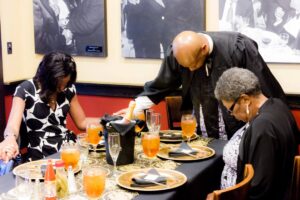On March 16, 2022, the most consistent and critical relationship to my spiritual and physical existence, the relationship between my mother, aka “MaDear, was changed due to her physical death. One of my favorite theologians is the Danish theologian Soren Kierkegaard who stated, “Life can only be understood backwards; but it must be lived forwards.” It is now, in the present, that I can reflect to what my MaDear was imparting to her son, “You are enough.” It was my mother who helped to shape and reinforce my God-given identity. As a black man raised and reared on a dirt road in the countryside of Alabama, I can now look back and see how critical the relationship between a black boy and his black mother is. One of the many life lessons since the onset of the COVID-19 pandemic is how humans value their relationships with each other. However, the most singular important voice in the holistic development of mind, body, and spirit starts with our mother. Here, we arrive at the place of understanding or misunderstanding ourselves, the inner black man. We, black men, stand against a capitalistic system designed to construct a double consciousness coupled with an internalized identity crisis that renders us physically alive, mentally mutilated, and spiritually dead with no hope. Yet, the very institution whose purpose is to counteract cultural catastrophe has failed to offer relationship restoration for black men has failed us. Where does the Black Church provide the spiritual sustenance that models masculinity? How has the Black Church evolved ministry approaches to address the missing minority in the pews, the black male? These questions offer an opportunity to develop a relational bridge to the Black Church between the black community where black men reside, hidden behind a veil that separates, and attempts to silence our minds.
Unfortunately, the Black Church focuses on social injustices impacting the black community, racism, the generational wealth gap, and mass incarceration while not addressing systemic uses of chronic absenteeism of the black male in the pews. I have curated a relational bridge, GodsArt Devotional, that leads black men to the Black Church by starting with the reimaging relationship with self and God. GodsArt is not a substitute for the Black Church but a spiritual supplement to the Black Church. Such black curation cultivation originated outside the Black Church’s boundaries and happened in the black community. Several black men spoke of a lack of relationship with the Black Church of today, yet held relationships within the black community that offered hope. Numerous Black Church cultures focus on keeping antiquated traditions and programs that miss the mark for black men. Men’s ministry in Black Churches is internalized bible study that gathers inside the church while alienating black men outside the Black Church boundaries in the black community. During several interviews with black men concerning masculinity, the word provider is critical to defining black masculinity and what it means to be a black man. When our identity connects to our ability to provide, this creates an internalized epicenter of an identity crisis. So black men congregate outside of the Black Church in barbershops, cigar lounges, 100 Black Men of America, fraternity events, and any other space that feeds their mind, body, and spirit. Black men exist in large numbers outside the Church, outside prisons and jails, but not in Church. Since black men are not coming to the Black Church, we must physically represent the Black Church in the spaces black men congregate outside of the boundaries of the physical location of the Black Church. Black men are the minority of minorities in the Black Church, chronically underrepresentation of black men is no longer acceptable by the status quo.
To address the chasm between the Black Church and the black community that houses black men, I developed a multifaceted spiritual tool to assist black men residing within the black community. This portable tool is fluid and functional beyond the Black Church and offers a relationship with self and God to address hopelessness. The methodology starts with reimagining the self as one with the Imago Dei, a self-centering care that is necessary to negate societal toxicity. This focus is a transformationally-centered relationship with self that allows black men to model black masculinity in God-given purpose.
GodsArt Devotional Concept
Intentionality in re-imagining space for dialogue concerning black masculinity for this project gave voice to the black community to contribute to the conversation and not just listen. Scholars’ engagement on masculinity and reimaging the relationship with masculinity between the Black Church and the Black community also invites non-traditional scholars to join in the dialogue.Reimaging black masculinity and the black church required me to reimage how I define scholarship—in a black community scholars are not limited those trained in academia! But the academy and church traditionally are the ones who define what constitutes scholarship. These people that I interviewed are seen as scholars to the black community because of their relationship with and their knowledge of the black community.
Such non-traditional scholars engaging in reimaging relationships outside of the boundaries of the academy or the Black Church are Gary Davis, CEO, of Next Level Boys Academy, serving young black males ages eight and up residing in the metropolitan Atlanta community. Mr. Davis, from a black community perspective, has the necessary training to contextually interpret the needs of those residing in the community due to his proximity and life training. Glenn Ford, Founder and CEO of IDareU Academy, cultivates training of young black men’s minds, bodies, and spirits. In addition, William H. Grier and Price M. Cobbs’s Black Rage is a painful perspective of the psychological damage to black men. Raphael Warnock’s The Divided Mind of the Black Church reflects the relational challenge and identity crisis within the Black Church. Along with Dr. Warnock, bell hooks We Are Cool and Michelle Alexander’s The New Jim Crow generate rich fertile ground for cultural conversations that promote re-imagining relationships with masculinity.
Based on the inspiration of these traditional and non traditional scholars, I constructed a spiritual bridge, GodsArt devotional, that is designed to give voice to the black community to define their needs and address relational deficiencies with black male identity crisis through relationship with self while simultaneously inviting black men into relationship with the Black Church. Such an invitation into a relationship with the Black Church is not the same invitation to attend the Black Church. Most traditional Black Church antiquated relational approach with the black community is focused on extending attendance for the black community to come to the Black Church. GodsArt devotional is the space for reimaging relationships starting with self and radiating outwardly with our micro community (friends, family, our circle). This devotional was created in the community and relocates power to define needs and wants to include black men’s voices located outside of the Black Church. The need for GodsArt exists due to the failure of the Black Church to effectively minister to the needs of black men that reimages black men in the imago dei. Reimaging twenty-first century black manhood is cultivated through engaging in proactive community through transformational centered dialogue, outside of reactive crisis movements similar to mobilization of NAACP and the Black Church to march or rally after tragedy. This proactive engagement is focused on three parts, the mind, the body, the soul/spirit of black men starting with the black self. Acknowledging, and defining toxic black masculinity in relationship to spirituality, and how this spirit of toxic black masculinity transcends as expressions of a physical representation of toxic black masculinity.
Positing self as central, is the starting point for GodsArt through a ontological lens that relocates self-centered as necessary as the imago dei. This launching pad, creates a foundation that includes the black male self, as central and connected to GOD as the source to all relationships. Relationships and the importance of relationships have been illuminated due to the coronavirus altering our everyday lives. God recentered the rhythm of humanity, by ordaining or permitting the coronavirus to mandate humanity shelter in place with self and immediate family. Thus, slowing down humanity created time and space for all of humanity to spend time with self. As a black man, the last person that we often clearly see is ourselves, and this devotion is curated so that black men specifically can see themselves as a uniquely whole being of mind, body, and soul. GodsArt devotion invites readers into daily practices
For Further Reading:
Alexander, Michelle. The New Jim Crow. New York: The New Press, 2010.
Copeland, Shawn M. Enfleshing Freedom. Minneapolis: Fortress Press, 2010.
DeGruy, Joy. Post Traumatic Slave Syndrome. Portland: Joy DeGruy Publications, 2005.
Ellison, Gregory C. Cut Dead But Still Alive. Nashville, TN: .Abingdon Press, 2013.
Warnock, Raphael G. The Divided Mind of the Black Church. New York: New York University Press, 2014.

